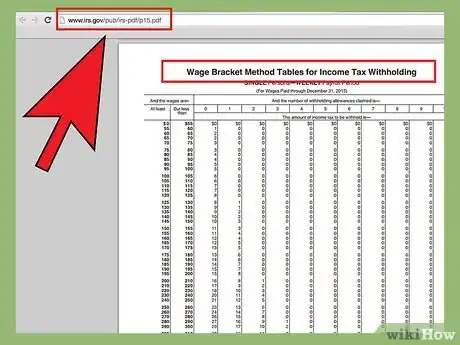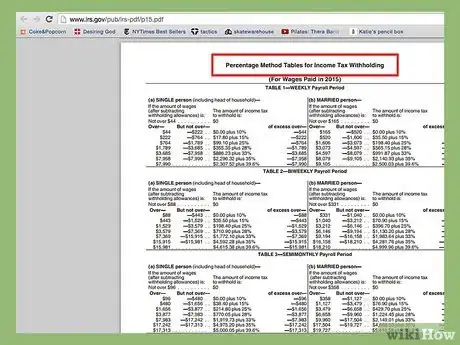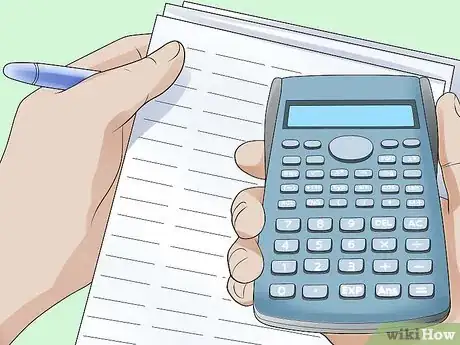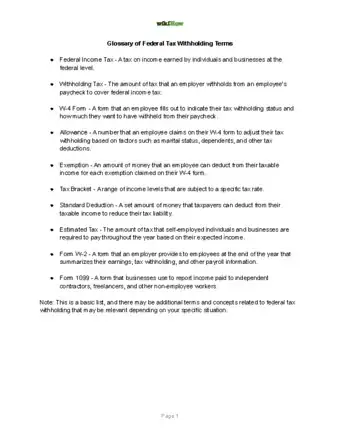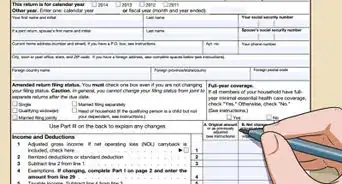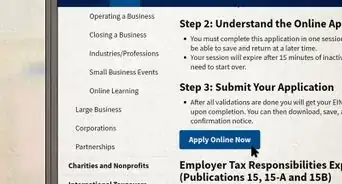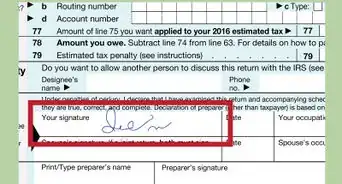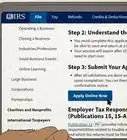This article was co-authored by Cassandra Lenfert, CPA, CFP®. Cassandra Lenfert is a Certified Public Accountant (CPA) and a Certified Financial Planner (CFP) in Colorado. She advises clients nationwide through her tax firm, Cassandra Lenfert, CPA, LLC. With over 15 years of tax, accounting, and personal finance experience, Cassandra specializes in working with individuals and small businesses on proactive tax planning to help them keep more money to reach their goals. She received her BA in Accounting from the University of Southern Indiana in 2006.
There are 9 references cited in this article, which can be found at the bottom of the page.
This article has been viewed 146,955 times.
Calculating federal tax withholding can be surprisingly frustrating — even though it's something the majority of people have to do regularly. Luckily, with the right guidance, this yearly ritual doesn't have to be a source of stress: each tax has its own set of laws and regulations associated with it, which (though sometimes complicated) are clearly outlined by the IRS. Learn how to calculate your federal tax withholding today to save yourself time and energy for years to come.
Steps
Using Useful Resources
-
1Use the IRS withholding calculator for a good estimate. There are many calculators online that can help you calculate about how much your federal withholding should be for the year. However, the most authoritative is probably the one offered by the IRS itself, available here: http://www.irs.gov/Individuals/IRS-Withholding-Calculator. This calculator allows you to input your income for the year and receive a reasonably accurate estimate both of your total withholding and of your refund.
- For the most accurate results, be sure to supply any tax credits, allowances, and deductions when prompted, though you can also ignore these for a quicker (and likely less accurate) result.
-
2Check your W-2 or 1099 for withholding information. After the end of every tax year, your employers are legally required to send you tax documents that contain important information about your income for the year. These forms almost always tell how much of your income was withheld for federal taxes (and state taxes as well, when applicable.) If you don't have this form, talk to your employer's payroll department to get a copy.
- Most employees will get a standard W-2 form from their employer.[1] If you are an employee at multiple businesses, you should receive a W-2 from each.
- On the other hand, independent contractors will receive a 1099 form from every customer they had that paid them more than $600 during the year.[2] 1099 forms are also used for miscellaneous types of income like retirement account payments, dividends from investments, and more.
Finding Your Yearly Federal Income Tax Withholding
-
1Find your gross income for the year. Your federal taxes are based on the amount of money you earn or receive during the year. The more money you make, the more taxes you owe, and the greater your withholding will be. Usually, you can find your gross income by adding up the totals on the end-of-year documents like W-2s and 1099s you receive from your employer(s).
- Note that tips, bonuses, commissions, and overtime pay are all taxable. In addition, many types of non-wage income, like retirement payments and even gambling income may be taxable.[3]
-
2Determine your filing status. Your federal tax withholding can vary greatly depending on how your life and family situation. While withholding rates can vary from year to year, as a general, single people almost always have the biggest withholding and married people have significantly lower ones. Filing statuses include:
- Single: Highest withholding.
- Married filing jointly: Smaller withholding.
- Married filing separately: Usually similar to single.
- Head of household: For unmarried people who are responsible for more than 50% of the costs of maintaining a home for themselves and dependents.[4] Smaller withholding than single, but not as small as married.
- Qualifying widow(ers): Special case for individuals whose spouse has died and who meet certain conditions (for more information, go to http://apps.irs.gov/app/withholdingcalculator/helpdocs/qw.htm).[5] Usually similar to married.
-
3Use a W-4 to find your allowances. Withholding exemptions called "allowances" dictate how much money is withheld from your wage income for tax purposes. As a general rule, the government takes a greater withholding from people who are single and have no children. This means, however, that these people usually get the biggest refunds at the end of the year. You can use an IRS form W-4 (available at http://www.irs.gov/pub/irs-pdf/fw4.pdf) to determine how many allowances to claim.
- If, for whatever reason, the form is not available, you should assume a filing status of single and 0 allowances. This will lead to the greatest withholding and the biggest refund at the end of the year.
-
4Total and subtract your deductions. Certain types of expenses are deductible — that is, if you spend money on them during the year, your taxable income goes down. Deductible items may include payments to retirement accounts (such as traditional IRAs and 401(k) plans), insurance premiums, health savings plans, some healthcare expenses, charitable donations, and more. Subtract your deductions from your income before finding your withholding.
- Expenses that are eligible for tax deductions can vary based on your living situation (single, married, etc.) and events that have recently occurred in your life. For a good resource on tax deductions, consult the eFile deduction guide, available at http://www.efile.com/tax-deduction/.[6]
- Note that you should only claim deductions if they total more than $12,200 for single filers; $18,350 if you file as head of household; or $24,400 for married filing jointly and surviving spouses — otherwise, use the standard IRS deduction, which is for these amounts.[7]
-
5Find your income withholding amount from your wage bracket. Now, you're ready to find your withholding amount. Follow carefully with the steps below to determine how much income will be withheld from your earnings.
- Consult IRS Publication 15 (Circular E), available at http://www.irs.gov/pub/irs-pdf/p15.pdf.[8] Turn to pages 48-67. Here, you will see tables that detail how much income should be withheld from your paycheck.
- Pick the page that has the filing status and pay period at the top of the page that match you.
- Find your income for the pay period on the left side of the table. The more frequent the pay period you're examining, the smaller your income will be.
- Move through the table to the right until you're under the column labeled with the number of allowances you claimed. This is the income withheld each pay period.
-
6Use the percentage method as an alternative. If you don't want to go through the process of finding your wage bracket or you make enough money that you can't find your bracket on the tables, use the percentage method instead. You can find information about this method on pages 45-47 of IRS Publication 15 (Circular E), available at http://www.irs.gov/pub/irs-pdf/p15.pdf. Follow the steps below to use this method:
- Multiply the number of allowances you are claiming by the appropriate amount as specified by Table 5 on page 45 based on the frequency of your pay period.
- Subtract this from your pay.
- Find the table on page 46 or 47 for your filing status and pay period.
- Follow the instructions on the table, using your pay minus allowances to find your tax rate.
-
7Use the provided example problems to your benefit. The 2 methods for finding your income tax withholding above are somewhat complex, so following along with an example problem (like the ones in Publication 15 itself) can help make them more manageable. See below for an example problem for each method:
- Wage bracket example: If you are single, you make $50,000 per year, and you are paid every week, go to the Single Persons, weekly pay period page. There are 52 weeks in a year, so 50,000/52 = $961, your weekly pay. Scroll down to the 953-964 row on the next page. Looking to the right, see that at 0 deductions, you have $115 withheld.
-
Percentage example: Let's say that you are married, you are paid $2,000 every 2 weeks, and that you are claiming 2 allowances. Using Table 5 on page 45, you should subtract 2 × 161.50 = $323.00 from your pay. 2,000 - 323.00 = $1,677.00. On page 46, you can use this number to determine your withholding.
- $1,677.00 after deductions puts you in the second row for tax purposes which means that your income above $1,200 is taxed at 12% . The total withholding per pay would be calculated as follows: (($1,677.00 - $1,200) x .12) + $74.60 = $131.80.
Finding Payroll Tax Withholding
-
1Use your gross pay × 6.2% for Social Security taxes. Unfortunately, the tax you pay to the federal government isn't just an income tax. If you work and earn income, you will almost always have to pay additional taxes called payroll taxes. These taxes are used to pay for important social programs — namely, Social Security and Medicare.[9] See below to learn how to calculate your Social Security taxes:
- The Social Security tax rate for 2019 is 6.2% for the employee portion and 6.2% for the employer portion. In other words, if you work for someone else, you pay 6.2% of your income as Social Security taxes and your employer matches this amount. Use your gross pay (your pay before any taxes are taken out) for this calculation.
- However, if you are self-employed, you must pay both the employer and the employee taxes, or 12.4%.
- The maximum earnings subject to Social Security tax for 2019 are $132,900. If you make more, you don't have to pay Social Security on the income over this threshold.
-
2Use your gross pay × 1.45% for Medicare taxes. The other main federal payroll tax is for Medicare. This, too, is a flat tax rate. See below to learn how to calculate this tax:
- Medicare tax rate for 2019 is 1.45% for the employee portion and 1.45% for the employer portion. As with Social Security, use your gross pay (your pay before any taxes are taken out) for this calculation.
- Once again, if you are self-employed, you pay both portions, or 2.9%.
- There is no maximum earnings limit for Medicare tax.
-
3Apply additional Medicare tax of 0.9% if you are a high earner. Wealthy individuals have to pay a small additional 0.9% tax on top of the normal Medicare tax. This tax applies only to income above a certain threshold — below this threshold, only the normal 1.45%/2.9% rate is applied. The threshold varies based on your filing status.
- Additional Medicare tax begins at earnings of:[10]
- $250,000 for Married filing jointly
- $200,000 for Single, Head of household, or Qualifying Widow(er)
- $125,000 for Married filing separately
-
4Add your payroll and income taxes to get your total withholding. Once you know your income tax withholding and your withholding for your payroll taxes, finding your total withholding is as simple as adding them together. Using an annual pay period for your tax calculations will give you your withholding for the year, while using your normal pay period will give you your withholding for each paycheck.
- Example: Let's say that you are single, you make $4,000 per week ($208,000 per year), you work for someone else, and you are claiming zero (0) allowances. You can find your withholding for the year with the following calculations:
- Income tax (percentage method): Withhold $896.70 per week plus 35% of the excess over $3,998. $4,000 - $3,998 = $2. $2 x 0.35 = $.070. $896.70 + $0.70 = $897.40, which would be withheld from each paycheck. $897.40 x 52 = $46,664.80 is the total amount that would be withheld for the year.
- Social Security: 6.2% of 132,900 of your earnings. 0.062 × 132900 = $8,239.80
- Medicare: 1.45% of income, plus 0.9% of income over $200,000. 0.0145 × 208000 = $3,016. 0.009 × 8000 = $72. 3016 + 72 = $3,088
- Total: $46,664.80 + $8,239.80 + $3,088 = $57,992.60
Glossary of Federal Tax Withholding Terms
Expert Q&A
-
QuestionHow are Medicare taxes handled in deductions?
 Cassandra Lenfert, CPA, CFP®Cassandra Lenfert is a Certified Public Accountant (CPA) and a Certified Financial Planner (CFP) in Colorado. She advises clients nationwide through her tax firm, Cassandra Lenfert, CPA, LLC. With over 15 years of tax, accounting, and personal finance experience, Cassandra specializes in working with individuals and small businesses on proactive tax planning to help them keep more money to reach their goals. She received her BA in Accounting from the University of Southern Indiana in 2006.
Cassandra Lenfert, CPA, CFP®Cassandra Lenfert is a Certified Public Accountant (CPA) and a Certified Financial Planner (CFP) in Colorado. She advises clients nationwide through her tax firm, Cassandra Lenfert, CPA, LLC. With over 15 years of tax, accounting, and personal finance experience, Cassandra specializes in working with individuals and small businesses on proactive tax planning to help them keep more money to reach their goals. She received her BA in Accounting from the University of Southern Indiana in 2006.
Financial Advisor & Certified Public Accountant Medicare payroll taxes are deducted in calculating your take-home pay from an employer. If you are a W-2 wage earner, Medicare payroll taxes are not an allowable tax deduction for you. If you are self-employed and pay both the employer and employee Medicare tax, the employer portion of the tax is deductible. This is calculated on Schedule SE.
Medicare payroll taxes are deducted in calculating your take-home pay from an employer. If you are a W-2 wage earner, Medicare payroll taxes are not an allowable tax deduction for you. If you are self-employed and pay both the employer and employee Medicare tax, the employer portion of the tax is deductible. This is calculated on Schedule SE.
References
- ↑ https://turbotax.intuit.com/tax-tools/tax-tips/IRS-Tax-Forms/What-is-a-W-2-Form-/INF14812.html
- ↑ https://turbotax.intuit.com/tax-tools/tax-tips/Self-Employment-Taxes/What-is-an-IRS-1099-Form-/INF14810.html
- ↑ http://www.irs.gov/Individuals/Employees/Tax-Withholding
- ↑ http://apps.irs.gov/app/withholdingcalculator/helpdocs/hoh.htm
- ↑ http://apps.irs.gov/app/withholdingcalculator/helpdocs/qw.htm
- ↑ http://www.efile.com/tax-deduction/
- ↑ https://www.forbes.com/sites/kellyphillipserb/2018/11/15/irs-announces-2019-tax-rates-standard-deduction-amounts-and-more/#72833fd12081
- ↑ http://www.irs.gov/pub/irs-pdf/p15.pdf
- ↑ http://www.ssa.gov/pubs/EN-05-10024.pdf






